在现在的scratch软件中,存在开启电脑内置摄像头的模块,但是无法开启网络摄像头这个功能,因此我来分享并记录一下我的一些经验。
开启网络摄像头
原有开启摄像头的实现
在正式开始之前先看一下原本开启电脑摄像头的逻辑是怎么写的。
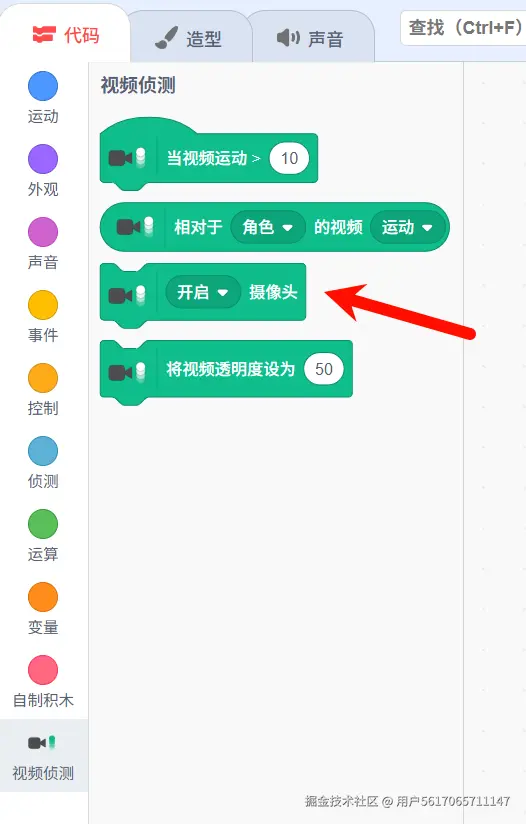
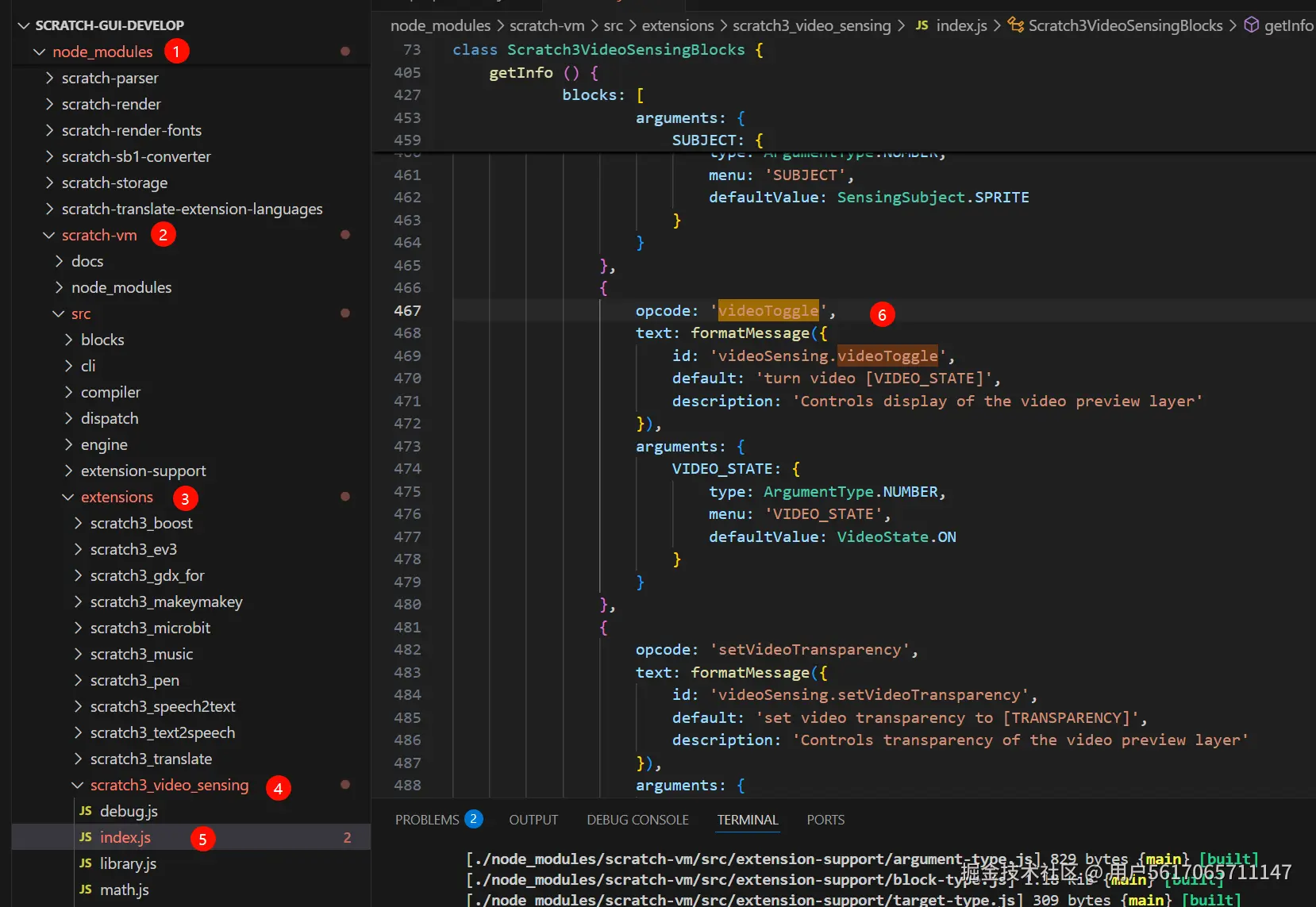
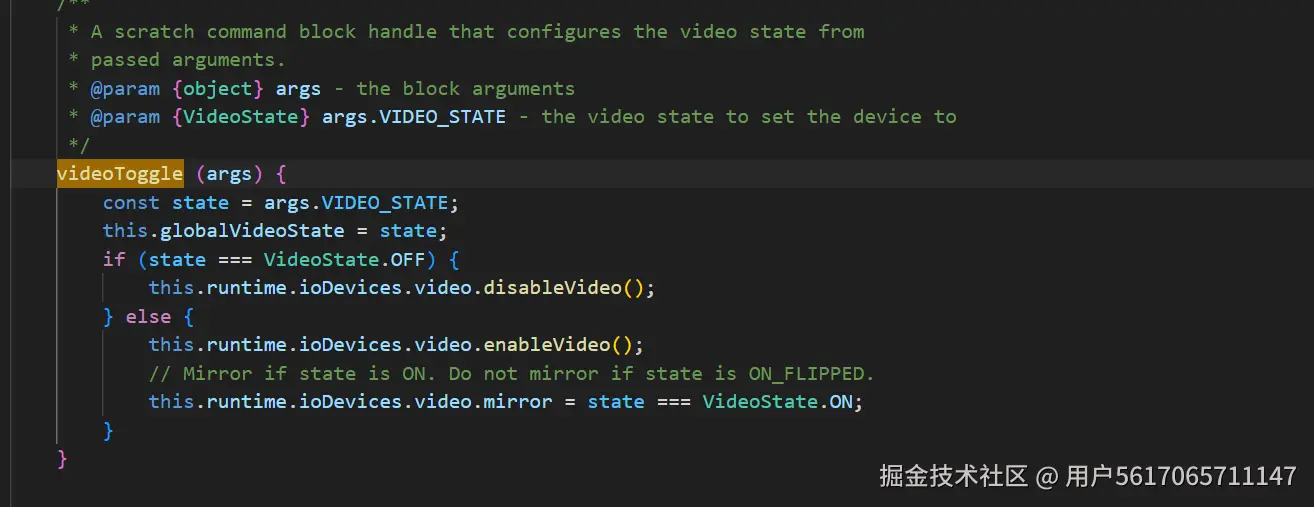
大家按照我的步骤可以很容易的找到开启摄像头这个块的执行逻辑,很显然这里调用了this.runtime.ioDevices.video这个的两个方法用来开启和关闭摄像头我们直接进入ioDevices后可以看到以下代码:
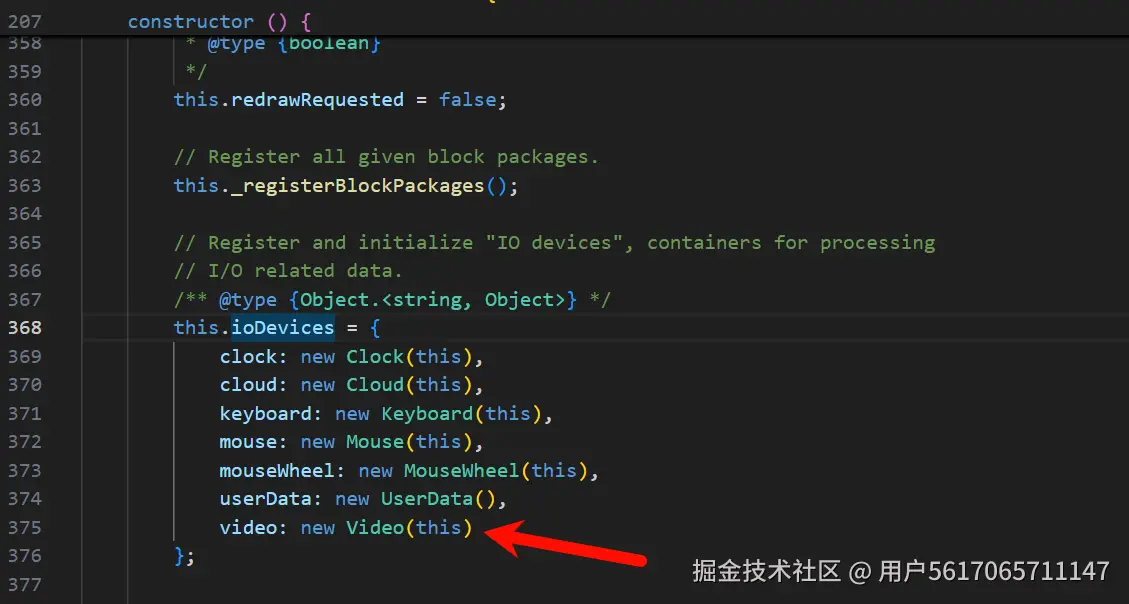 这里我们再进入Video类
这里我们再进入Video类
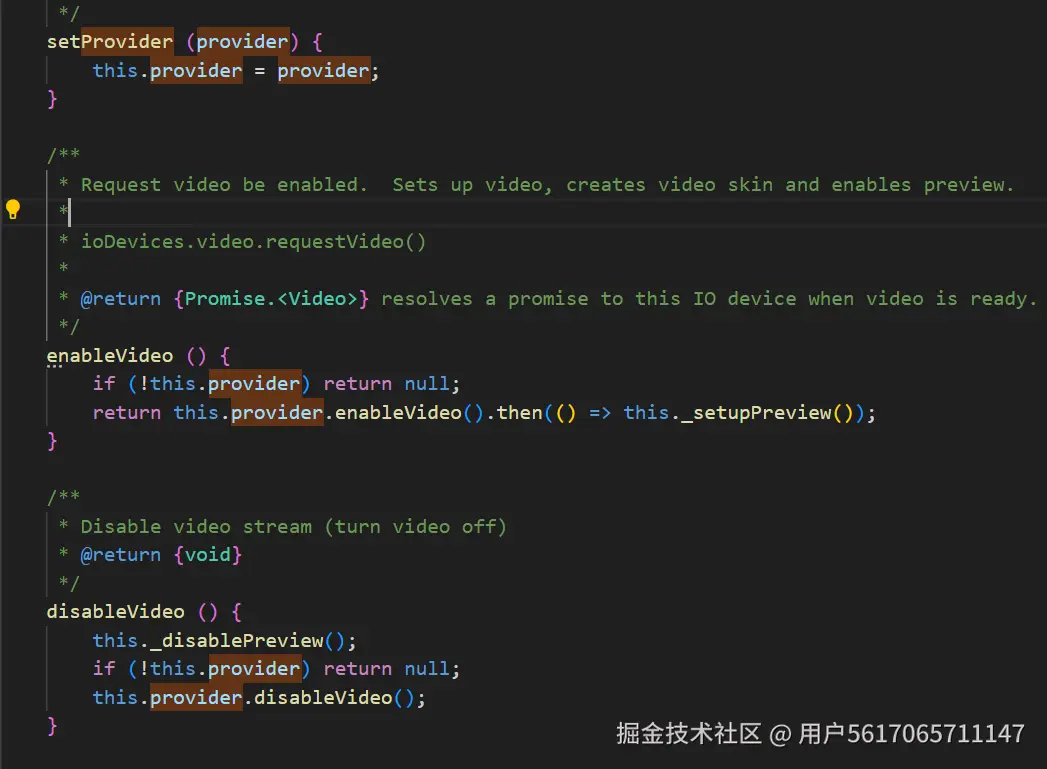
这三个函数是开启关闭摄像头的关键,想必大家也发现了,这里面用到了provider来开启摄像头,可是这个provider在哪里呢,这个文件里面provider默认为空,那肯定是在别的地方动态定义了他的具体内容,我们接着找,由于我开发过一段时间的scratch了,所以我第一反应可能是在以下目录中的文件有相关该内容的定义
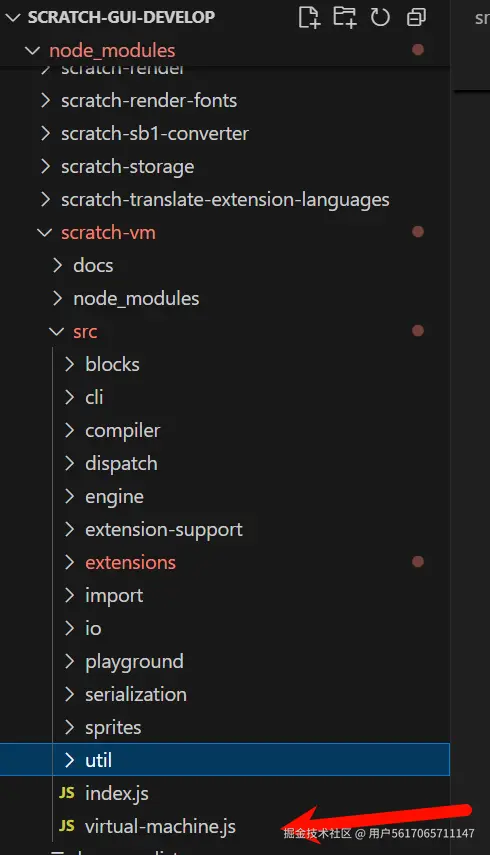
我直接ctrl+f全局搜索provider果然找到了相关内容
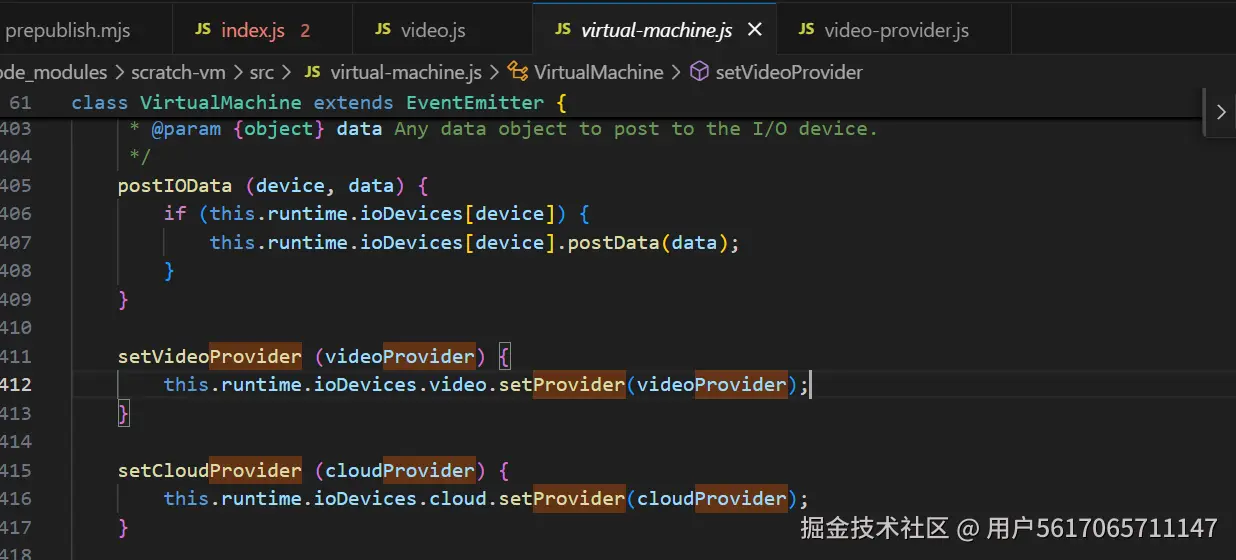
接下来直接使用vscode里面的全项目的搜索来搜索setVideoProvider函数的调用的地方
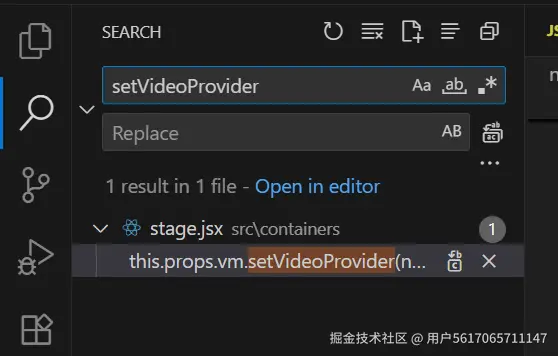
直接找到哈哈哈
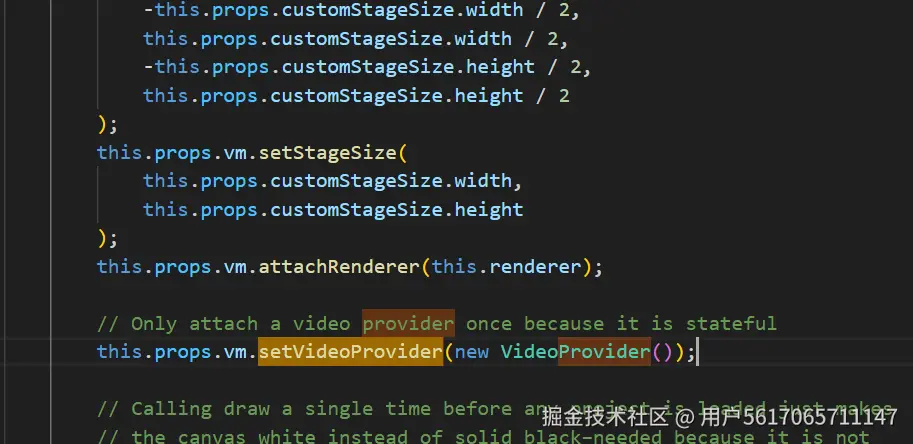
这里就很清晰了,把new出来的VideoProvider的对象设置到了原来那个video.js中的this.provider中,也就是默认的开启电脑摄像头的功能就是调用的VideoProvider里面的enableVideo方法,还是老办法,ctrl+点击进入VideoProvider类里面
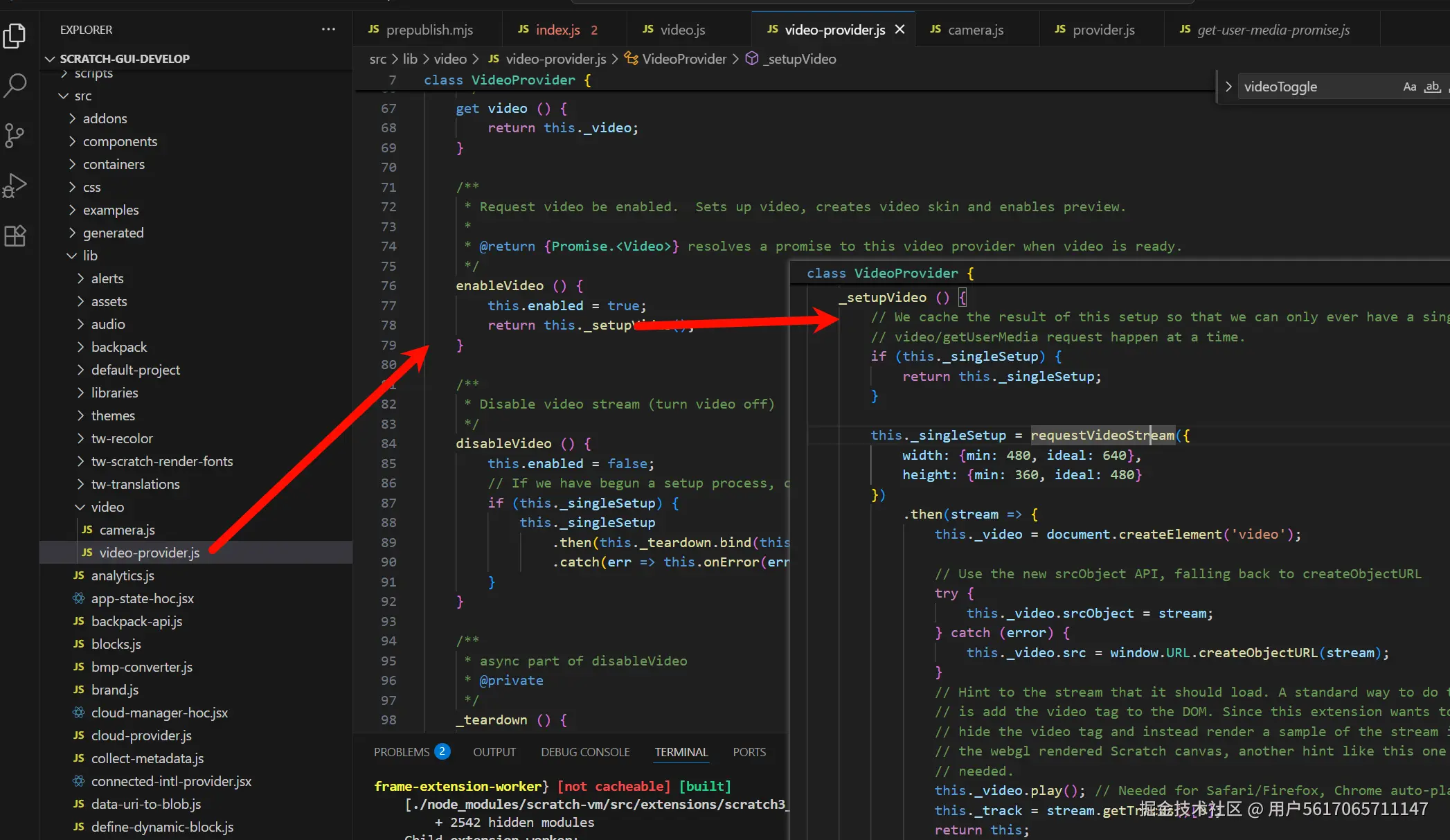
如果你也跟着我找到了这里,恭喜你,你已经了解了,scratch舞台区开启摄像头的流程,其实我们还可以继续往下找,可以看到又进入了当前目录下的camera.js目录,这里直接调用了getUserMedia用来开启摄像头。
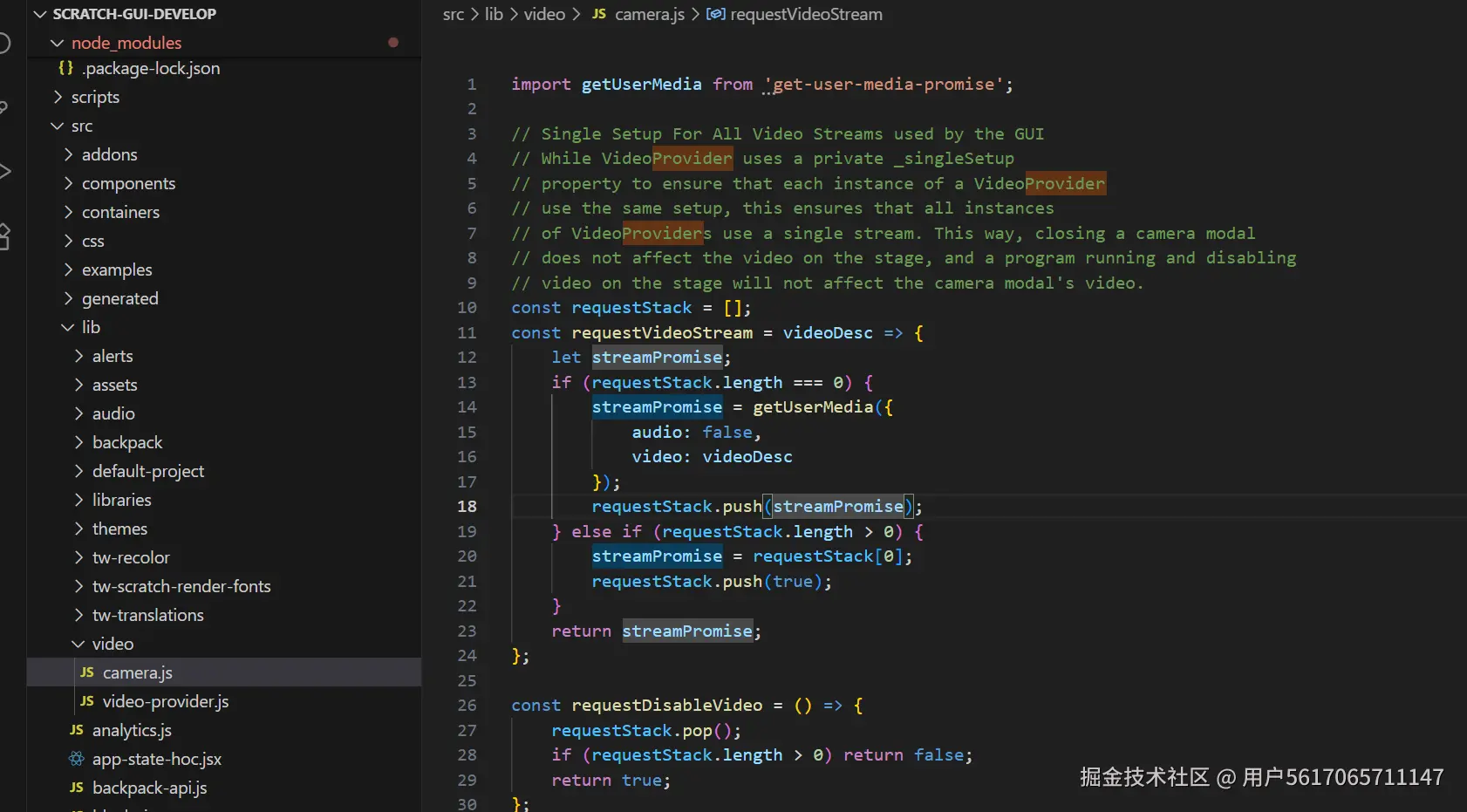
开启网络摄像头
由于我这里的开启的网络摄像头是通过esp32开启摄像头模块后,将图像以图片的形式传输到esp32本地服务器上的形式,可以通过ip+端口的形式获取图像流,所以我要用img标签来接收。想必通过前面的流程大家一定猜到了我们第一步需要干啥,恭喜你!!!猜对了,就是写一个我们自己的provider,接下来,我将给大家提供一个provider模板,这个模板是在我的项目基础上进行删除精简之后得到的,删除了我的其他更复杂的逻辑,有一定可能会导致bug出现,不过不用担心,经过上面的介绍大家应该以及了解了开启摄像头的流程,不会出现很严重的bug,如果出现问题,大家可以随时在评论区与我交流
js
let lastHash = null;
let unchangedFrames = 0;
const MAX_UNCHANGED = 8;
/**
* Video Manager for video extensions that handle image-based video streams.
*/
class Provider {
constructor (ip) {
/**
* Default value for mirrored frames.
* @type boolean
*/
this.mirror = false;
/**
* Cache frames for this many ms.
* @type number
*/
this._frameCacheTimeout = 16;
/**
* Image element to hold the image stream
* @private
*/
this._img = null;
/**
* Canvas element to render frames
* @private
*/
this._canvas = null;
/**
* Context for the canvas
* @private
*/
this._context = null;
/**
* Stores the last update time for caching
* @private
*/
this._lastUpdate = 0;
this.timer=null
this._ip=ip
}
static get FORMAT_IMAGE_DATA () {
return 'image-data';
}
static get FORMAT_CANVAS () {
return 'canvas';
}
/**
* Dimensions the image stream is analyzed at after being rendered to the canvas.
* @type {Array.<number>}
*/
static get DIMENSIONS () {
return [480, 360];
}
/**
* Order preview drawable is inserted at in the renderer.
* @type {number}
*/
static get ORDER () {
return 1;
}
/**
* Request video be enabled. Sets up image stream, creates video skin, and enables preview.
*
* @return {Promise.<VideoProvider>} resolves a promise to this video provider when video is ready.
*/
enableVideo () {
this.disableVideo()
this.enabled = true;
return this._setupImageStream();
}
/**
* Disable the image stream (turn video off).
*/
disableVideo () {
console.log('disable')
this.enabled = false;
this._teardown();
}
/**
* async part of disableVideo
* @private
*/
_teardown () {
if (this._img) {
this._img.src = ''; // Clear the image source to stop the stream
this._img = null;
}
if (this._canvas) {
this._canvas = null;
this._context = null;
}
}
/**
* Return frame data from the image feed in a specified dimensions, format, and mirroring.
*
* @param {object} frameInfo A descriptor of the frame you would like to receive.
* @param {Array.<number>} frameInfo.dimensions [width, height] array of numbers. Defaults to [480, 360]
* @param {boolean} frameInfo.mirror If you specifically want a mirror/non-mirror frame, defaults to true
* @param {string} frameInfo.format Requested video format, available formats are 'image-data' and 'canvas'.
* @param {number} frameInfo.cacheTimeout Will reuse previous image data if the time since capture is less than
* the cacheTimeout. Defaults to 16ms.
*
* @return {ArrayBuffer|Canvas|string|null} Frame data in requested format, null when errors.
*/
getFrame ({
dimensions = Provider.DIMENSIONS,
mirror = this.mirror,
format = Provider.FORMAT_IMAGE_DATA,
cacheTimeout = this._frameCacheTimeout
}) {
if (!this._img || !this.enabled) {
return null;
}
if (this._img && this._img.complete && this._img.naturalWidth === 0) {
return null;
}
try{
const [width, height] = dimensions;
const now = Date.now();
// Check if the image needs to be redrawn or if it's within cacheTimeout
if (this._lastUpdate + cacheTimeout < now) {
this._lastUpdate = now;
if (mirror) {
this._context.scale(-1, 1);
this._context.translate(width * -1, 0);
}
// Draw the image onto the canvas
this._context.drawImage(this._img, 0, 0, this._img.width, this._img.height, 0, 0, width, height);
this._context.setTransform(1, 0, 0, 1, 0, 0);
}
// console.log(this._canvas.toDataURL('image/png'))
// Return frame in requested format
if (format === Provider.FORMAT_IMAGE_DATA) {
return this._context.getImageData(0, 0, width, height);
} else if (format === Provider.FORMAT_CANVAS) {
return this._canvas;
}
return null;
}catch(e){
return null
}
}
/**
* Method called when an error happens. Default implementation is just to log error.
*
* @abstract
* @param {Error} error An error object from getUserMedia or other source of error.
*/
onError (error) {
console.log.error('Unhandled video io device error', error);
}
/**
* Create an image stream using the provided URL.
* @private
* @return {Promise} Resolves when the image stream is set up.
*/
async _setupImageStream () {
// Create the img element and set its src to the network camera feed URL
this._img = document.createElement('img');
this._img.crossOrigin = "anonymous"; // 允许跨域访问
// const timestamp = new Date().getTime();
this._img.src = `http://${this._ip}:81/stream?ts=${Date.now()}`; // Set the image feed URL here
this.timer=setTimeout(() => {
this._img.src = ''; // Clear the image source to stop the stream
this._img = null;
alert("加载超时,请检查网络或摄像头状态!");
}, 6000);
this._img.onload = () => {
clearTimeout(this.timer)
console.log('Image loaded, currentSrc:', this._img.currentSrc);
console.log(this._img)
// Create a canvas to render the image frames
this._canvas = document.createElement('canvas');
this._canvas.width = Provider.DIMENSIONS[0];
this._canvas.height = Provider.DIMENSIONS[1];
this._context = this._canvas.getContext('2d');
};
this._img.onerror = (error) => {
console.error('Failed to load image feed:', error);
};
console.log(this._img.src)
return new Promise((resolve, reject) => {
if (!this._img) {
this.channelLoad.postMessage(false)
alert('图传加载失败,请检查后重试')
reject('Failed to initialize image stream');
} else {
resolve(this);
}
});
}
/**
* Start the image loop to continuously fetch the next frame from the image stream.
* @private
*/
_startImageLoop () {
setInterval(() => {
if (this._img) {
// Reload the image to get the next frame
this._img.src = `http://${this._ip}:81/stream?ts=${Date.now()}` // Adding timestamp to force reload
}
}, 100); // Fetch a new image every 100ms (adjust based on your feed's speed)
}
get videoReady () {
return this._img !== null && this.enabled;
}
}
module.exports=Provider在以上文件中需要修改的地方只有
js
this._img.src = `http://${this._ip}:81/stream?ts=${Date.now()}`;这个地方,网络摄像头的路径,ip可手动传入
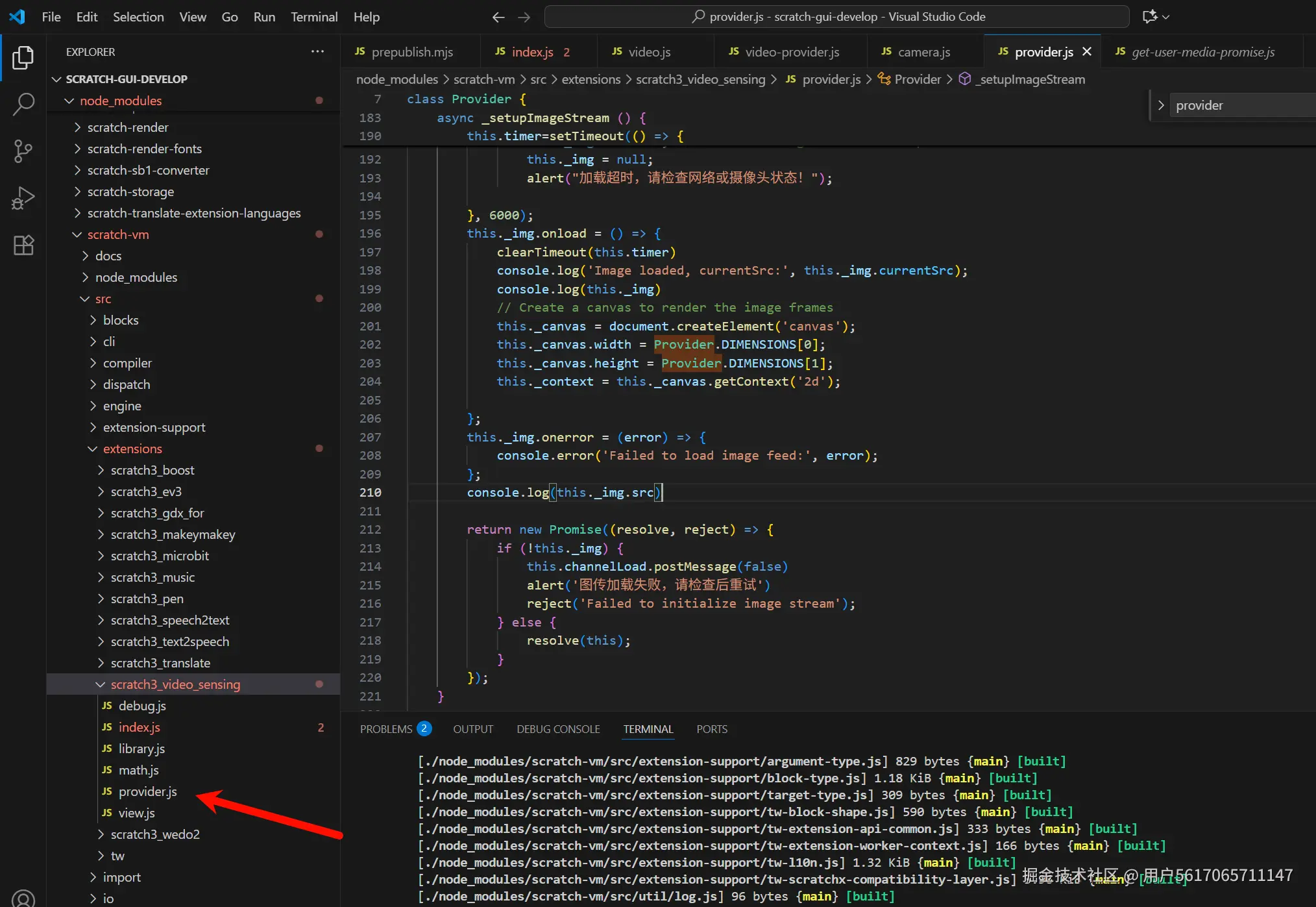
大家可以在上图所示位置新建一个provider.js文件,并将上述代码复制进去
接下来需要修改provider.js同级目录下的index.js文件,我会给出具体步骤:
js
const Provider = require('./provider') //导入provider
js
this.videoProvider=this.runtime.ioDevices.video.videoProvider; //用于记录默认的provider
js
//新建开启网络摄像头的模块,这里就不使用formatMessage国际化方法了,我们暂时不需要翻译
{
opcode: 'videoNet',
text: '[VIDEO_STATE]网络摄像头',
arguments: {
VIDEO_STATE: {
type: ArgumentType.NUMBER,
menu: 'VIDEO_STATE',
defaultValue: VideoState.ON
}
}
},
js
videoToggle (args) {
const state = args.VIDEO_STATE;
this.globalVideoState = state;
this.runtime.ioDevices.video.setProvider(this.videoProvider) //恢复原有的provider
if (state === VideoState.OFF) {
this.runtime.ioDevices.video.disableVideo();
} else {
this.runtime.ioDevices.video.enableVideo();
// Mirror if state is ON. Do not mirror if state is ON_FLIPPED.
this.runtime.ioDevices.video.mirror = state === VideoState.ON;
}
}
//模块的执行逻辑,可以直接复制上面原有的方法然后稍作修改
videoNet (args) {
const state = args.VIDEO_STATE;
this.globalVideoState = state;//我们也可以给网络摄像头添加一个类似的参数,来确保只能开启一个摄像头,这个就交给大家来完成了,很简单if..else就行了
this.runtime.ioDevices.video.setProvider(new Provider('ip')) //将我们新建的provider赋值,并且传入ip,这个ip大家也可以在块里面让用户输入
if (state === VideoState.OFF) {
this.runtime.ioDevices.video.disableVideo();
} else {
this.runtime.ioDevices.video.enableVideo();
// Mirror if state is ON. Do not mirror if state is ON_FLIPPED.
this.runtime.ioDevices.video.mirror = state === VideoState.ON;
}
}好了,完成以上操作,我们就大功告成了,运行起来软件,导入视频侦测的扩展后就会发现多了一个块
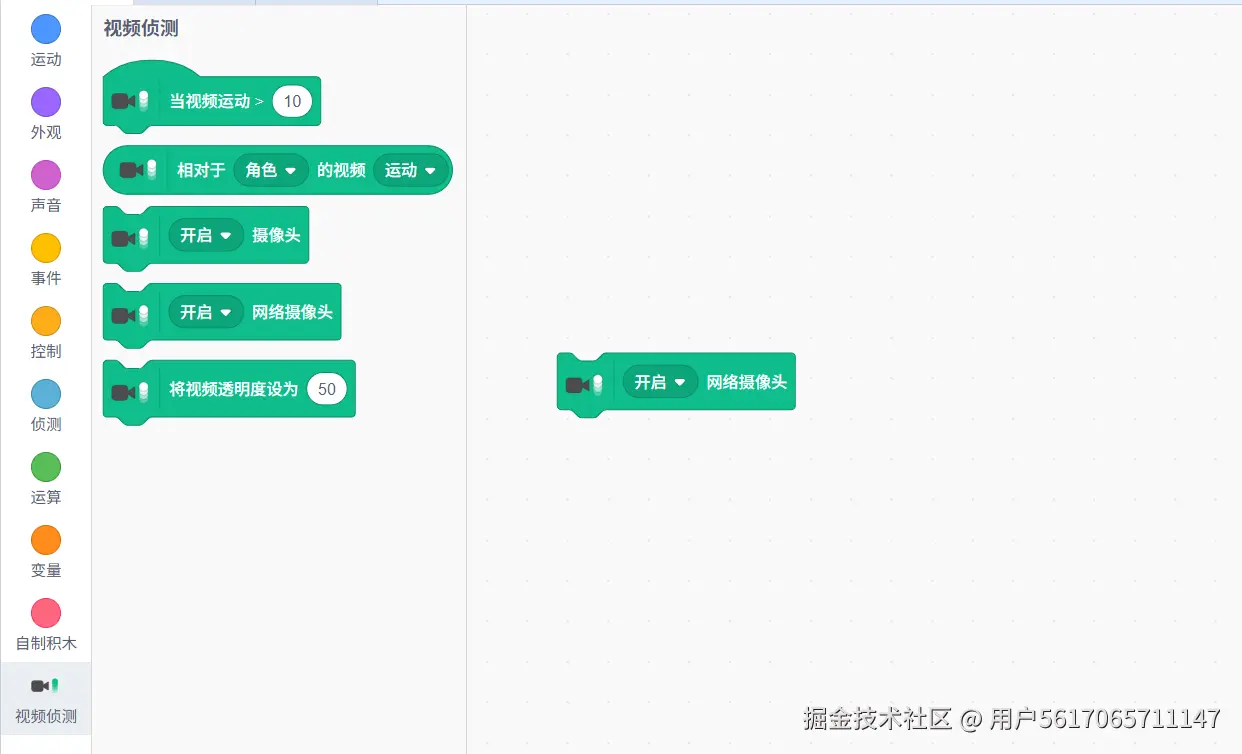
直接点击即可开启网络摄像头。
声明:
1.本帖的代码是在我原本的代码上精简而来的,我并没有来的及验证,可能会有些许问题,如有问题出现,大家及时在评论区留言。
2.在以上的代码修改中,仅作展示使用,属于不规范开发,还是要尽量避免对原有文件的修改,比如我们可以新加一个扩展用于开启管理网络摄像头,添加扩展的步骤可以看下面的博主,这个博主解释的很详细:scratch 3.0二次开发---插件添加_scratch3扩展
好了,该和大家说再见了,本次分享到此结束了,下一节将会分享如何选择开启usb摄像头还是电脑默认摄像头